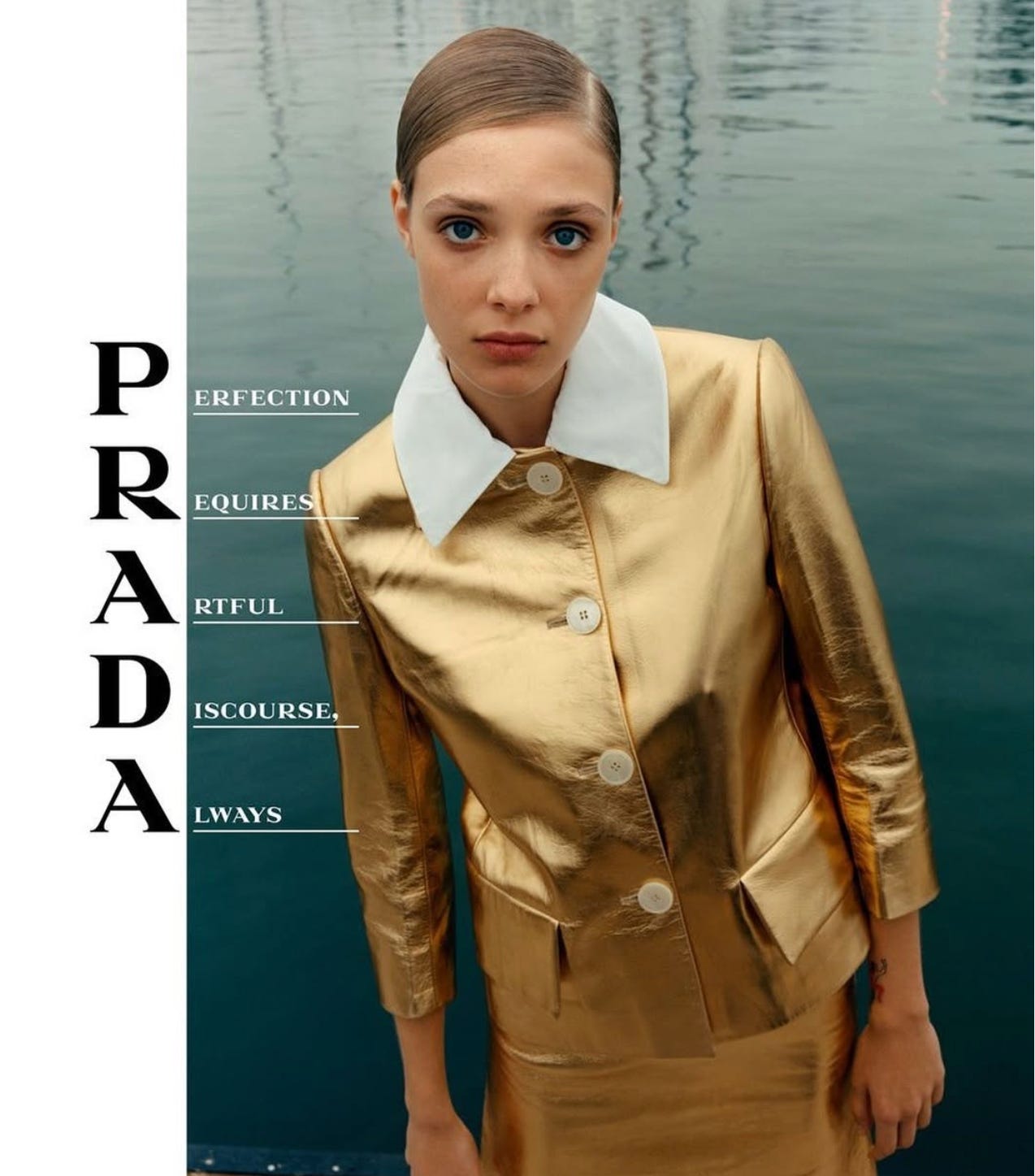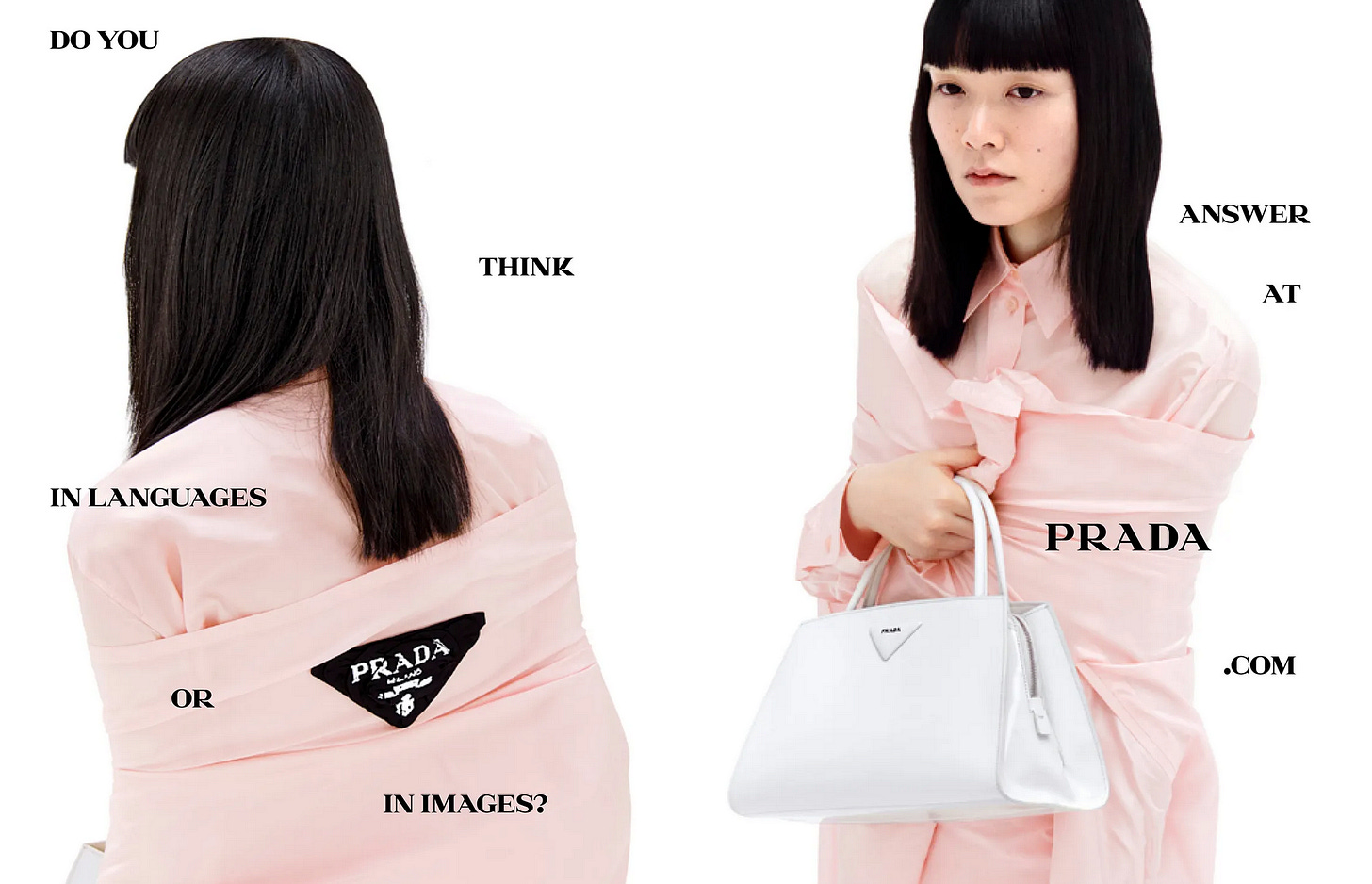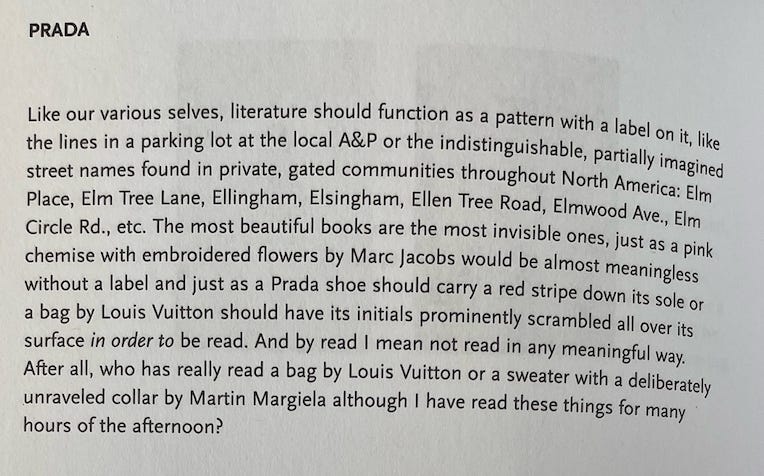I wrote this for Viscose Journal 6: Text (2024). The designed pdf of the article is here.
“Do you think in languages or in images?”
For Spring/Summer 2021, Prada designed a collection of questions to accompany their ready-to-wear. The advertising campaign for that season, “Dialogues,” consists of a series of minimal diptychs. In print, these appear as two shots of a single model—one Prada outfit, one pensive face—split across two white pages and accessorized by two sentences of text in Prada’s black serif. The verso of the spread is always an enigmatic question; the recto, a simple injunction: “Answer at prada.com.” These open-ended questions might ask us to express a preference between a pair of vague alternatives or to define the difference between two concepts; all either implicitly or explicitly invite us, the reader, to reflect on our selves—our ways of thinking, our points-of-view. According to a press release, the responses submitted to prada.com “will become components of the campaign’s continued rollout, vital parts of a dialogue that will continue.” But really these campaign questions are, of course, rhetorical ones, meant less to provide an avenue for us to tell Prada who we are, than for Prada to tell us who it is.
What, then, is Prada? Well, Prada might say, that’s the question! Branding is usually about sending a message; Prada, we learn, is an inquiry. Countless other Prada campaigns tell—or ask—us the same thing: one perfume is “an invitation to open new possibilities to play and question convention” that is (dis)embodied by the “ethereal” Candy, a digitally rendered “virtual muse” born from the brand’s “DNA of curiosity” and “driven by a continuous quest to question.” The conventions being questioned are often equally ethereal: idealized dichotomies that are, as in “Dialogues,” proposed by Prada only to be dismantled in the same slogan. The Spring/Summer 2022 collection “collided actuality and fantasy, the physical and the cerebral.” A series of pop-up stores manifests the brand’s “aesthetic codes” in an architectural style somewhere “between modernism and classicism, embellishment and purism.” Pradaness is always emerging from this space of instability that both links and divides terms—what, in Pradaspeak, might be called a “Paradoxe,” the name of another perfume, embodied, this time, by Emma Watson, a woman “breaking the mould of the muse to be both in front of and behind the lens.” Deconstruction, by whatever name, has never smelled so sweet.
Prada, like most luxury fashion houses, likes to advertise itself as in a state of continuous “re-interpretation.” At Gucci, a handbag originally released in 1991, the Diana, “speaking to the narrative of evolution and reinvention that runs through Gucci’s designs,” is “reimagined by Alessandro Michele in three different sizes.” The archetypal Miss Dior is regularly reincarnated in a fresh face and stale 1950s frock. Prada’s recent Symbole handbag expresses this insistently recursive branding quite concisely: in a nicely fractalline visual tautology, the shape of the whole bag is inspired by the triangular logo that has marked their brand since 1919. These gestures towards historical continuity are not only reminders of each house’s storied pasts, they’re also meant to make us feel like each is the expression of a kind of personality or spirit. A luxury fashion brand is a little like an immortal undergoing psychoanalysis.
But Prada’s self-interpretations read as especially neurotic, not least for their emphases on language. The Spring/Summer 2020 campaign, for example, revolved around a series of invented acronyms for “P.R.A.D.A.”—the name converted, here, into a potentially infinite set of sentences. What did Prada (want to) mean, by way of this solipsistic semiotic game, in the spring or summer of 2020? “People Rarely Accept Difficult Answers,” says one ad. Several models are filmed engaging in abstracted forms of play: deep in concentration, stacking a column of dice; hiding an orange under a paper cup; tugging on a rope. Play of signifiers, indeed!? Prada’s real message finds its medium neither in a triangle nor even in a single, five-letter word, but in the linguistic pastime “P.R.A.D.A.” Consistently redundant, P.R.A.D.A. always uses five words where one would suffice, like a thesaurus-happy freshman trying to hit a word count. From the SS20 campaign:
The multitude characterizes Prada, an ever-shifting landscape of meaning, endlessly reinterpreted… Like the identity of women today, the identity of Prada too is fluid, fluctuating, open to interpretation—confounding explanation, eschewing rhetoric, refuting definition. The paradox and contradiction inherent to Prada make easy categorization or summarization impossible: Prada is simultaneously complex and simple, singular yet multi-faceted…
There is a power to the word as a tool to define, and in Prada’s case, to challenge definitions, to re-define, de-contextualize and recalibrate, to evoke an imaginary narrative and hence change our eye as we examine the picture plane. An attempt at an impossible definition becomes a manifesto for the impossibility of definition itself.
The Prada campaign evolves around a series of written acronyms, spelling out the word PRADA. Like the images they are placed alongside, each of these acronyms offers a possible interpretation of the idea of Prada, but only one of many. Ironic, surreal, ambivalent, dichotomic, these many attempts at definition ultimately only prove the indefinability of Prada as a single concept or idea.
The prose style is a perfect example of what we’ve come to know as “International Art English,” that bastardization of (mostly French, 20th century) theory commonly found in art world press releases: an unedited moodboard of abstract nouns connected, technically if not sensibly, by commas. Theory has a couple of diffusion lines in the realm of commodities; art and fashion are two of its most expensive down-market products. It’s no coincidence, surely, that Prada has always been particularly proximate to the art world—Miuccia Prada’s OMA-designed museum in Milan is only one of the brand’s countless collaborations with artists and architects.
Obvious enough why a clothing company might align itself with art or theory: to spritz its all-too-worldly wares with an air of intellect. It’s easy to condemn the Prada Group’s arts patronage as a cynical gesture that shows the total capture of art by capitalism; it is more interesting to consider the potential artfulness and intelligence of dressing and living fashionably. This is what Miuccia Prada asks us to do when she stages her models against monochrome backdrops that recall the blankness of gallery walls, or gives contemporary artists shoes, handbags, and her permission to install a Prada storefront in the Texan desert as a “pop architectural land art project.” Similarly, instead of dismissing P.R.A.D.A. as an overwritten, under-thought theory knockoff, I would rather take seriously the specificity of this genre of language, this appropriation of theory-as-style. What does it mean to read Prada’s texts on their own terms? What mode of reading does P.R.A.D.A. call for?
Despite P.R.A.D.A.’s loquaciousness, words almost never appear on the brand’s clothing, shoes, and bags themselves. Everywhere else in luxury fashion, words are in: Dior, Fendi, Louis, and Gucci’s bestsellers are plastered with typographical prints that abstract their brand names into illiterate patterns of interlocking initials. In the context of these ubiquitous condensations of language, P.R.A.D.A.’s acronymic expansions of its name read as almost subversive. As a 2018 Vogue article on logomania put it: “The written word is one of the most valuable commodities in fashion at the moment . . . logos have sold more clothes in the past couple years than any single trend.” By way of explaining this trend, the article goes on to quote graphic designer Mathias Augustyniak: “Now more than ever, clothes need to express their origin right away… To nurture a tridimensional language takes a lifetime.” Apparently, fashion designers no longer have time to write in their own sartorial language, to create clothes that are recognizably their own, without the shorthand of writing. Or maybe it’s that consumers no longer have time to read them. Either way, according to Vogue, it’s because of the speed of our society, phones, and social media.
An interesting example here is Gucci, whose recently-departed Alessandro Michele was known for collections that combined a kaleidoscope of historical and cultural references—including theory—into a symbolically maximalist aesthetic privileging story, character, and world-building. His Gucci show notes were known for namedropping multiple B.A.s’ worth of theorists —Baudrillard, Benjamin, Butler, Debord, Deleuze, Derrida—in a bibliographical logomania that mirrored Michele’s visual citational practice. In addition to the classic double-G logo and the red-green Gucci stripe, under Michele, bags, belts, and tees were increasingly ornamented by a whole menagerie of non-linguistic emblems: bumblebees, snakes, tigers, and butterflies, each representing some aspect of the polyvalent “Gucci.” This inflation of the brand’s symbolic economy correlated with skyrocketing sales; less than two years into Michele’s tenure, Gucci saw its sharpest revenue increase in twenty years—49 percent.
Michele’s passion for iconography extended to other kinds of statements as well: Gucci’s 2020 Cruise collection, which included a purple jacket emblazoned with “My Body, My Choice” and a dress embroidered with a flowery pink uterus, is just one of many instances of fashion-world political signaling in recent years. Positions must be made legible, as must origins or inspirations. Looking at fashion recently can feel like skimming a syllabus. Michele’s theory-inspired collections, too, expressed his references quite literally. The FW18 collection, apparently inspired by Donna Haraway’s “Cyborg Manifesto,” was staged in an operating room and accessorized by prostheses. The SS20 collection, inspired by Foucault, was set in a mental asylum and features straitjackets, leather, and other “discipline and punish” gear. If, in Michele’s designs, animals and colors became word-like—visual data flattened into hieroglyphs—the work of “theory” happened similarly: names and books found visually encoded representation, like appliqué patches (also beloved of Michele) advertising allegiances: Pro-Choice, Elizabeth II, Sonic Youth, Post-Structuralism.
Rather than transposing symbols culled from politics and other aesthetic spheres onto garments, Prada’s language speaks in manipulations of material. Raf Simons’s and Miuccia Prada’s clothes are no media, or vehicles, for meanings constructed via other means; their effects derive from their idiosyncratic articulations of qualities inherent to clothing. SS23, for example, featured lingerie-like garments fused with outerwear. This “blurring of distinct realities,” as the show notes put it, was achieved neither through a bricolage of subcultural signifiers, nor by, say, putting men in skirts. The realities being blurred were the functional and material features of garments themselves: a morning robe over a winter jacket. If the coat has value, it is reducible neither to its pricetag nor to a ‘principle’—say, a statement on woman’s role in the public realm—it is, like in painting, a question of shades and tones, the aesthetic impact of light and sheer with heavy and opaque.
Miuccia Prada, famously, could have gone into politics; instead, she chose fashion. She has often spoken of her interest in addressing contemporaneity, and her work engages many kinds of non-sartorial languages (film, art, architecture)—but these sources undergo a one-way translation, the unravelling of which isn’t very P.R.A.D.A. at all. Her garments aren’t statements; they’re fashion: an elevation of both form and function, and of living itself.
For clothing, in the end, is meant to be lived in! Miuccia Prada frequently insists that her work is not art. Her interventions into the fabric of everyday life are subtle ones. And this is, finally, how we must read Prada’s ad language: as something wearable. Although the exhibition press release and Prada’s theoryspeak blurbs are stylistically similar bits of copy, the goods they advertise occupy fundamentally different dimensions of our lives. Art is meant to be appreciated within the white-walled heterotopia of the gallery space. Even once it has been sold into the space of a living room, the art object always brings its own backdrop; it appears in a kind of permanent vacuum. The language that accompanies it is therefore fundamentally distant, objective—a material manifestation of critical distance being, in art, the actual product being advertised. But clothing, makeup, and perfume take place not only in our daily lives, but on our bodies. They confer an effect on our gestures, faces, gait—our entire character. The language used to advertise them, therefore, is less a critical language than a language to be lived in.
Or, rather, a language in which we are meant to dream of living in. If clothing creates a reality, advertising generates desire. P.R.A.D.A. is, of course, meant to put us “In the Mood for Prada,” as the SS22 campaign goes. The slogan seems to reference In the Mood for Love (2000), but there are otherwise no encodings of Wong Kar-Wai’s film. “Prada” becomes, then, the signifier that can stand in for any word—in this case, “love” itself. The campaign is a beautiful riff on one of Don Draper’s best aphorisms: “What you call love was invented by guys like me to sell nylons.” An ad campaign is distinguished from a clothing catalog because it does not operate 1:1, with definitions, with information, but with much more oblique strategies of making meaning: by routing desire through other objects, stories, and worlds. In this sense, P.R.A.D.A.’s insistence on instability of meaning is advertising in its purest—or, at least, in its most self-aware—form.
The question, then, becomes: what is it that P.R.A.D.A. is teaching us to desire?
It isn’t Studio 54, Renaissance Italy, or punk music. If Gucci’s campaigns are hyper-situational mise-en-scenes of garments, Prada’s texts and images are floating signifiers, unmoored from context, much less “story” or “world.” Let’s return to our reading of the SS20 ad copy above. It’s a text that might have been written by a GPT trained on the totality of postmodern philosophy books. Although clearly evocative of “theory,” there are no concrete citations here. In short, it means nothing. Removed from any real analytic context or specific philosopher’s vocabulary, the statements have the dizzying quality of cleverly mimicking concepts, but communicating little. They preserve only the form of theory, not its contents. What this text—and all the acronymic expansions; empty, halo’d signifiers we have encountered thus far—do betray is a love for writing in its purest form; for words in themselves, divorced from the information they might convey; for the texture of ideas; for the style of theory and the surface of its language. Rather than presenting us with a Paradoxe, Prada’s a-signifying minimalism vis-a-vis clothing design actually helps us to read the maximalism of their flowery written language. P.R.A.D.A. does not think in languages or in images, but writes—in fabric. Rather than being merely redundant, the many repetitions that embroider Prada’s ad copy become sensorial, coalescing into something like a pattern. (Because P.R.A.D.A. always functions via a play on words, we might note that the SS23 collection inverts this textilic ad copy by itself becoming paper: dresses are made from a paper-like fabric; sweaters are crumpled to resemble fine tissue paper; skirts are torn, as though out of a notebook; and bags are folded into neat, origami-like shapes.)
P.R.A.D.A., in other words, is language as luxury. It figures theory as something that one can desire to live in, and therefore, of course, buy. What to make of this commodification, this materialization, of “theory”—by a luxury brand, no less? Surely one cannot buy the position of critique. But can one even wear it? The question reminds me of an old debate: over the piety produced in a girl—or not—by wearing a pretty gold cross, for example; over the spirituality destroyed or engendered by beautiful paintings of the Virgin. It returns us to the relationship between material, body, image, and thought. What is thinking, where does it come from, what form does it take? (You can’t buy knowledge, for sure, but who doesn’t know the appetite for learning produced by the look of new paper and pencils, back to school shopping at Staples?) I love P.R.A.D.A. because it opens up these questions for me, the real questions of philosophy.
P.R.A.D.A., at the very least, puts us in the mood for reading. For if these texts are accessories to, rather than explanations of, fashion, they are also elevations not only of clothing, but writing! The point of language isn’t merely to mean something, just as the point of a purse isn’t only to carry your keys. Theory is also an aesthetic form. Abstraction, like the clothes on your back, is a source of desire as much as it is an everyday, livable, necessary human function. And desire, like abstraction, operates playfully, by substituting one thing for another. All of this is written in P.R.A.D.A. These advertisements also know that real reading is always interpretation, an experience in the form of a question. And perhaps, for some, the desire to question might—who knows?—be roused by a purse in Pocono nylon.




